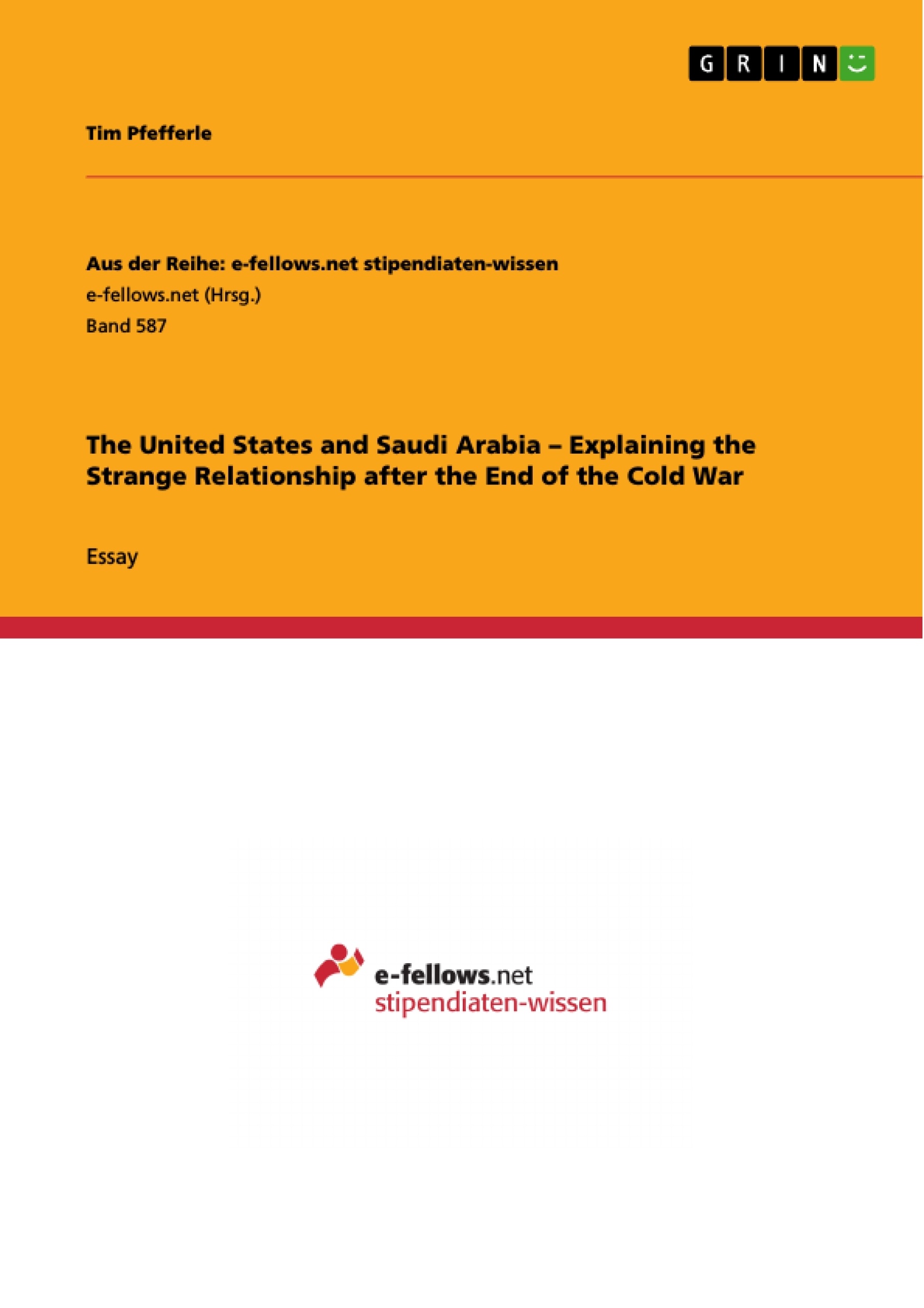Excerpt
The United States and Saudi Arabia – Explaining the Strange Relationship after the End of the Cold War
“Saudi Arabia is, in a phrase, a goddamn mess, and it’s our goddamn mess. The United States made Saudi Arabia the private storage shed for our oil reserves” (Baer, 2004: 205)
“These two countries were frenemies long before anyone coined the term – and for better or worse, they will be ambivalent allies for a long time to come.” (LeVine, 2011: 2)
Introduction
In 2011, the Middle East was subject to the great transformation that was termed the Arab Spring, sweeping countries from Tunisia to Libya and Egypt. Currently, a violent revolution is still taking place in Syria. The one major country which seems to have escaped major challenges is Saudi Arabia. Coincidentally, Saudi Arabia is the main strategic partner of the United States in the region, whose mutual relationship extends as far back as the 1930s. Thus, the US has clear stakes in what happens or does not happen in Saudi Arabia. Yet, at first sight the alliance between these two countries appears curious. The Unites States, purportedly a role model of the values of democracy and human rights is acting as one of the most crucial allies of one the most repressive regimes to be found anywhere. Moreover, this regime is and has been a staunch opponent of the state of Israel, the same state which is usually regarded as a US protectorate. Lastly, Saudi Arabia has been accused of sponsoring terrorist activities, which is obviously a major concern for the United States. Yet, in 2012 the United States and Saudi Arabia still regard each other as mutual allies.
How can we explain this strange relationship? This paper will aim to provide an explanation for this apparent puzzle. In order to do so, the focus will be laid on the period after the end of the Cold War, as the explanatory model shifted from a combination of anti-Communism and access to oil resources to counterterrorism and regional security. The conventional explanation centering on the oil for security paradigm will be challenged as a comprehensive illustration of the relationship’s character. Thus, a twofold argument will be presented. First, it has served as the main regional power to combat Iranian ascendancy in the Middle East, a concern which is shared by both the United States and Saudi Arabia. Secondly, it will be argued that, particularly after 9/11, Saudi Arabia became a crucial partner in the effort to provide effective counterterrorism activities. Thus, while oil may still be a crucial component to the US-Saudi relationship, it cannot account for its strength and resilience.
Historical Background
Since any detailed rendering of the pre-Cold War relations between the United States and Saudi Arabia would go beyond the scope of this paper, there will only be a short discussion of what are considered the fundamental principles of the relationship before 1990. With regard to the Middle East as a whole, Kamrava identifies three primary objectives of US foreign policy (2011: 196). First, the United States aimed to maintain the post-1948 territorial status in the Middle East in terms of boundaries. Secondly, the US sought to secure access to the Middle East’s oil reserves for itself and its Western allies. Lastly, facing the Cold War it aimed to contain both regional as well as global allies.
In terms of United States foreign policy towards Saudi Arabia, Kamrava’s analysis can be broadly extrapolated. While the first objective has certainly been an issue with regard to the Israeli-Palestinian conflict in the context of US-Saudi relations, US policies in the Cold War focused mainly on the latter two objectives. Thus, Bronson argues that, with regard to oil, the United States’ view was that “Saudi oil […] was to become the lifeblood of Europe’s economic and political recovery” (2006: 45). The rationale here was twofold: On the one hand, the US needed to ensure the viability of Europe as a market for American goods. On the other, it needed to be strong enough to be an effective counterweight to Soviet influence on the continent (Miglietta, 2002: 222).
Similarly, US-Soviet rivalry was the main catalyst for America’s third objective: containing the Soviet Union and its client states in the Middle East. To do so, Saudi Arabia would act as a decisive ally in the region, since, being a “deeply religious state, [it] was the perfect prophylactic against the spread of Communism and a natural American partner” (Bronson, 2006: 26). A prime example of Saudi Arabia’s anti-Communist role is its coordination of the Islamic jihad against the Soviet invasion and subsequent occupation of Afghanistan in the 1980s (bin Hethlain, 2010: 249). With the loss of the Shah in Iran in 1979, Saudi Arabia would remain as the region’s sole policeman, which would thereafter also be used to counter the new Iranian regime’s influence in addition to combating the Soviet Union (Ibid: 25).
However, the idea that the US and Saudi Arabia “would automatically be on the same side in an international conflict […] ended with the Cold War” (Gause III, 2011: 23). Thus, for the purposes of this paper, the focus will be on the different nature of the US-Saudi relationship after the end of the Cold War.
[...]
- Quote paper
- Tim Pfefferle (Author), 2012, The United States and Saudi Arabia – Explaining the Strange Relationship after the End of the Cold War, Munich, GRIN Verlag, https://www.grin.com/document/205797
Publish now - it's free






















Comments